
The cicadas are a superfamily, the Cicadoidea, of insects in the order Hemiptera. They are in the suborder Auchenorrhyncha, along with smaller jumping bugs such as leafhoppers and froghoppers. The superfamily is divided into two families, Tettigarctidae, with two species in Australia, and Cicadidae, with more than 3,000 species described from around the world; many species remain undescribed.

The Hemiptera or true bugs are an order of insects comprising some 50,000 to 80,000 species of groups such as the cicadas, aphids, planthoppers, leafhoppers, bed bugs and shield bugs. They range in size from 1 mm (0.04 in) to around 15 cm (6 in), and share a common arrangement of sucking mouthparts. The name "true bugs" is often limited to the suborder Heteroptera. Many insects commonly known as "bugs", especially in American English, belong to other orders; for example, the lovebug is a fly and the May bug and ladybug are beetles.

Brood X, the Great Eastern Brood, is one of 15 broods of periodical cicadas that appear regularly throughout the eastern United States. It has the greatest range and concentration of any of the 17-year cicadas.

Magicicada is the genus of the 13-year and 17-year periodical cicadas of eastern North America, consisting of seven species. Although they are sometimes called "locusts", this is a misnomer, as cicadas belong to the taxonomic order Hemiptera, suborder Auchenorrhyncha, while locusts are grasshoppers belonging to the order Orthoptera. Magicicada belongs to the cicada tribe Lamotialnini, a group of genera with representatives in Australia, Africa, and Asia, as well as the Americas.
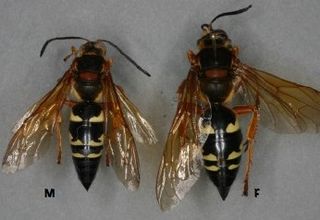
Sphecius speciosus, often simply referred to as the cicada killer or the cicada hawk, is a large digger wasp species. Cicada killers are large, solitary wasps in the family Crabronidae. The name may be applied to any species of crabronid which preys on cicadas, though in North America it is typically applied to a single species, S. speciosus. However, since there are multiple species of related wasps, it is more appropriate to call it the eastern cicada killer. This species occurs in the eastern and midwest U.S. and southwards into Mexico and Central America. They are so named because they hunt cicadas and provision their nests with them. In North America they are sometimes called sand hornets, although they are not hornets, which belong to the family Vespidae. Cicada killers exert a measure of natural control on cicada populations and thus may directly benefit the deciduous trees upon which their cicada feed.
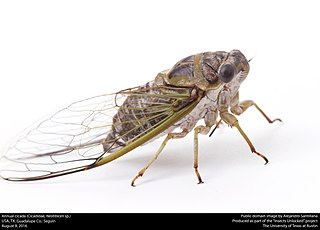
Cicadidae is the largest family of cicadas, with more than 3,200 species worldwide. The oldest known definitive fossils are from the Paleocene, a nymph from the Cretaceous Burmese amber has been attributed to the family, but could also belong to the Tettigarctidae.

Cicadas of the genus Neotibicen are large-bodied insects of the family Cicadidae that appear in summer or early fall in eastern North America. Common names include cicada, harvestfly, jar fly, and the misnomer locust. Until recently, these species were all in the genus Tibicen, which was redefined in the twenty-first century to include only a few European species, while species from the Western United States and Mexico are now placed in a separate genus, Hadoa. In addition, several former Neotibicen species have been moved to the genus Megatibicen.

Cicada killer wasps are large, solitary, ground dwelling, predatory wasps. They are so named because they hunt cicadas and provision their nests with them, after stinging and paralyzing them. There are 21 species worldwide. The highest diversity occurs in the region between North Africa and Central Asia.

The Auchenorrhyncha suborder of the Hemiptera contains most of the familiar members of what was called the Homoptera – groups such as cicadas, leafhoppers, treehoppers, planthoppers, and spittlebugs. The aphids and scale insects are the other well-known "Homoptera", and they are in the suborder Sternorrhyncha. Lesser-known insects largely regarded as Homoptera are the Coleorrhyncha. However, the taxonomic status of the Hemiptera and Homoptera is currently under investigation and discussion. See Heteroptera and Prosorrhyncha for more information.
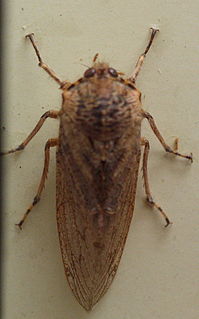
The Tettigarctidae, known as the hairy cicadas, are a small relict family of primitive cicadas. Along with more than 20 extinct genera, Tettigarctidae contains a single extant genus, Tettigarcta, with two extant species, one from southern Australia and one from the island of Tasmania. Fossil taxa include Paratettigarcta from the Miocene of New Zealand, Meuniera from the Paleocene of France, and Sanmai from the Late Jurassic of China, and Maculaferrum of early Late Cretaceous Canada.Tettigarcta are the closest living relatives of the true cicadas.

Cicada is a fictional character appearing in American comic books published by DC Comics.
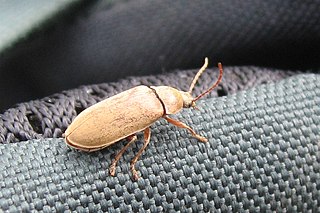
Dascilloidea is a superfamily of polyphagan beetles, comprising two families: Dascillidae and Rhipiceridae.
Cicada lore and mythology is rich and varied as there are c. 2500 species of cicada throughout the world, many of which are undescribed and remain a mystery to science. Cicada has been prized as a delicacy, and are famed throughout the world for their song.
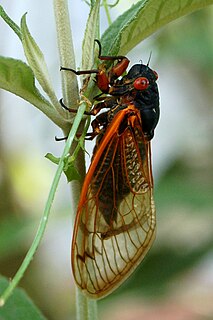
Brood XIX is the largest brood of 13-year periodical cicadas, last seen in 2011 across a wide stretch of the southeastern United States. Periodical cicadas are often referred to as "17-year locusts" because most of the known distinct broods have a 17-year life cycle. Brood XIX is one of only three surviving broods with a 13-year cycle. It is also notable because it includes four different 13-year species, one of which was discovered in Brood XIX in 1998 by scientists listening to cicada songs.

Magicicada cassinii, sometimes called the 17-year cicada, Cassin's periodical cicada or the dwarf periodical cicada, is a species of periodical cicada. It is endemic to North America. It has a 17-year lifecycle but is otherwise indistinguishable from the 13-year periodical cicada Magicicada tredecassini. The two species are usually discussed together as "cassini periodical cicadas" or "cassini-type periodical cicadas." Unlike other periodical cicadas, cassini-type males may synchronize their courting behavior so that tens of thousands of males sing and fly in unison. The specific name cassinii was in honour of John Cassin, an American ornithologist.

Thopha saccata, commonly known as the double drummer, is the largest Australian species of cicada and reputedly the loudest insect in the world. Documented by the Danish zoologist Johan Christian Fabricius in 1803, it was the first described and named cicada native to Australia. Its common name comes from the large dark red-brown sac-like pockets that the adult male has on each side of its abdomen—the "double drums"—that are used to amplify the sound it produces.

Aleeta curvicosta is a species of cicada, one of Australia's most familiar insects. Native to the continent's eastern coastline, it was described in 1834 by Ernst Friedrich Germar. The floury baker is the only described species in the genus Aleeta.
James Homer "Casey" Hayes was an American Thoroughbred racehorse trainer whose horses won eight national Championship titles of which two were inducted in the National Museum of Racing and Hall of Fame.

Cicada 3301 is a nickname given to an organization that, on three occasions, has posted a set of puzzles to recruit codebreakers from the public. The first internet puzzle started on January 4, 2012, on 4chan and ran for nearly a month. A second round began one year later on January 4, 2013, and then a third round following the confirmation of a fresh clue posted on Twitter on January 4, 2014. The third puzzle has yet to be solved. The stated intent was to recruit "intelligent individuals" by presenting a series of puzzles which were to be solved. No new puzzles were published on January 4, 2015. However, a new clue was posted on Twitter on January 5, 2016. In April 2017, a verified PGP-signed message was found. It explicitly denies the validity of any unsigned puzzle. A verified puzzle has not been posted since.

Cicadettinae is a subfamily of cicadas in the family Cicadidae. About 230 genera and 1,200 described species are placed in the Cicadettinae.
















